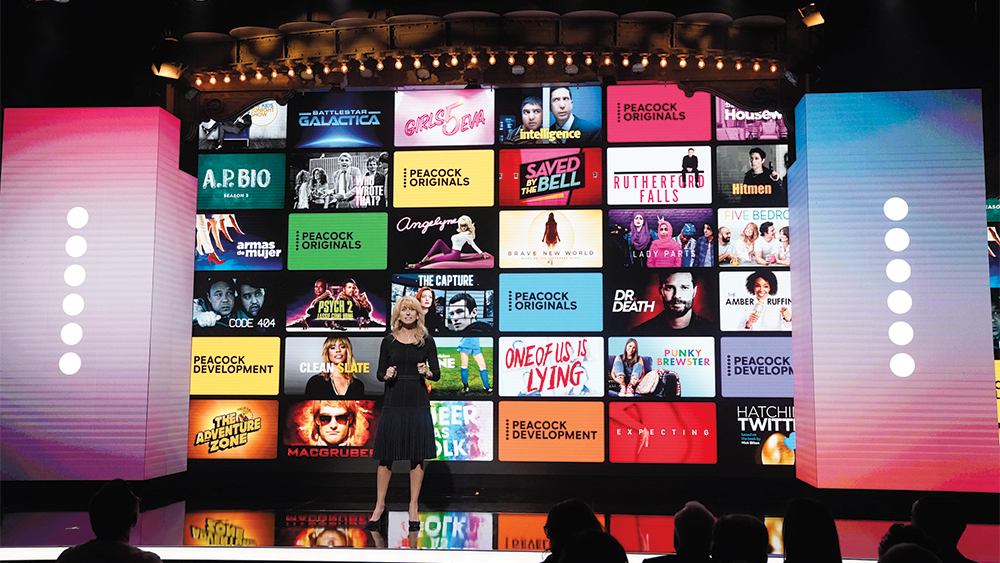NBCUniversal’s Peacock Gets an Enthusiastic Reception From Wall Street
By Elaine Low
LOS ANGELES (Variety.com) – You’d think that the steady drumbeat of streaming services being launched might dull the senses, but Wall Street is rather eager to embrace Peacock. NBCUniversal’s new over-the-top entertainment platform sent shares of corporate parent Comcast to an all-time high after its unveiling at the company’s Jan. 16 investor day. The service brought to you by one of America’s oldest traditional broadcasters, it turns out, might be setting a new inflection point for the streaming industry with its innovative use of … advertising.
“Across the three major launches — Disney Plus, HBO Max and — we thought Peacock stood out in terms of uniqueness of the product and the underlying drivers of value,” wrote Barclays analyst Kannan Venkateshwar.
The service comes in three varieties: free and ad-supported for 7,500 hours of content, including current-season TV, library programming, curated daily news, sports and Spanish-language programming; $4.99 a month for Peacock Premium, which offers twice as much content, earlier-window availability and 4k; and a completely ad-free version of Peacock Premium for $9.99. Certain Comcast customers get access to the service April 15, while the national rollout happens on July 15. (At some point, Peacock will also fly abroad.)
Like Disney Plus, HBO Max, Apple TV Plus and others, Peacock will also house originals; in its case, from the likes of Tina Fey, Kevin Hart, Amy Poehler and Mindy Kaling, in addition to reboots of titles like “Punky Brewster” and “Saved by the Bell.”
What’s making the investment community pleased as punch isn’t the idea of a “best of” channel of “Saturday Night Live” moments, however — it’s the idea that advertising might have a place in this cord-cutters’ world after all.
“We believe less than 3% of advertising budgets globally [are] allocated to streaming although streaming represents 20%-30% of all TV viewership,” wrote Wedbush analyst Dan Ives, “thus speaking to a potential turning point as more services like Peacock go after the advertising piece.”
Netflix, for example, bars commercials from its platform but famously spends an ever-increasing amount of money for content every year. (In 2020, experts expect that figure to exceed $17 billion.)
Disney Plus and Amazon Prime Video also do not support ads. Furthermore, Guggenheim Partners’ Mike McCormack says that with less than five minutes of ads per hour of programming, Peacock will have the “lightest ad load in the industry.” For comparison, Hulu’s ad-supported tier runs around 9-10 minutes of commercials every hour, say analysts.
McCormack, who echoes Venkateshwar’s sentiment that the ad-supported premium model sets Peacock apart from its streaming peers, wrote in a note to clients that the service will “likely test the appetite for streamers to accept ads.”
He also believes that the amount the industry is spending on content at this juncture is “too aggressive, and will result in mediocre content being greenlighted, but Comcast enters the fray with very compelling proprietary content, including the upcoming Olympics.”
Comcast plans to pour $2 billion into Peacock over the next two years, and expects to break even on this commitment by the end of 2024; that should translate, it projects, into $6-$7 of average revenue per user from both ads and subs by then, resulting in $2.5 billion in revenue.
expects Peacock to have 30 million to 35 million active accounts by 2024, an estimate that Wedbush’s Ives believes is conservative. Given Peacock’s breadth of content and its distribution footprint, he sees 20 million subs over the next 12-18 months as a “realistic” goal.
There is the concern, though, that Peacock’s method of differentiation between its tiers — i.e., earlier window availability, more content costing more money — while subtler than some of its peers, is potentially more problematic.
“This can be a bit tricky to pull off in our view because the experiential difference of content volume or nature is difficult to communicate without use, but tiering based on ads or no ads (as Hulu does) or caps on number of simultaneous users (like Netflix does) is easy to communicate,” wrote Venkateshwar.
Nevertheless, the introduction of Peacock to the already crowded streaming market presents possibly the most interesting battle to come: the potential to topple Netflix from its long-held perch.
Says Ives: “While it will take some time for the likes of Peacock and Apple streaming to gain traction, we continue to believe the trifecta of Disney (we believe 40 million subs by end of 2020 now a realistic goal), Peacock and Apple, with HBO soon unveiling its streaming service, will clearly disrupt the leader Netflix and its subscriber trajectory in this streaming battle over the coming years.”

